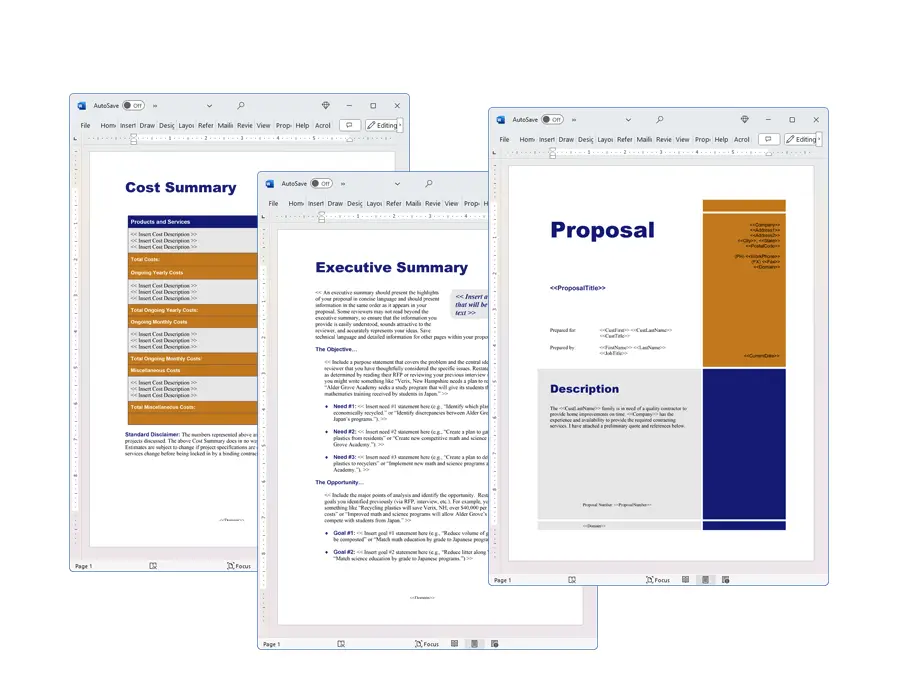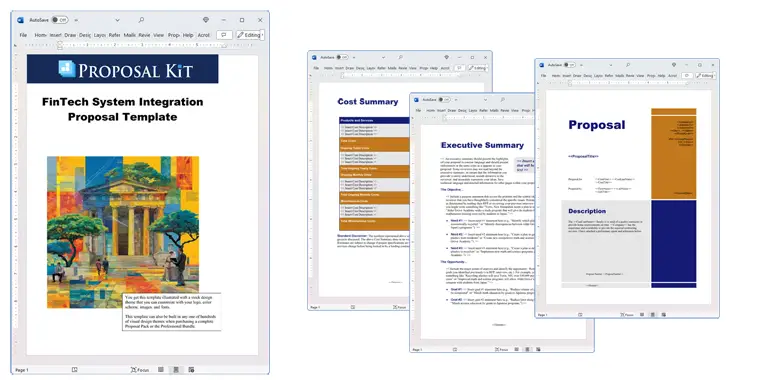How to write your FinTech System Integration Proposal Template
We include this 19 page layout with every Proposal Pack. If you want this template to have a different visual design theme than the one illustrated here, purchase any Proposal Pack design and create this template using the purchased design theme. This template is included in every Proposal Pack. If you get a Proposal Pack or the Professional, you can also make any variation of this template with different chapters to suit your needs.
We typically include more chapters in the templates than most people will need to give everyone more variety in the chapters they may need. You can trim down a long template by removing pages you do not need or combining multiple chapter topics into one page.
 DOWNLOADABLE, ONE-TIME COST, NO SUBSCRIPTION FEES
DOWNLOADABLE, ONE-TIME COST, NO SUBSCRIPTION FEESYou can also create countless variations of this document to suit your needs using the included library of 2200+ chapters if ordering a Proposal Pack or Professional.
 What Our Clients Say
What Our Clients SayThe Proposal Packs, wizard, and Estimate templates helped me to organize my thoughts and allowed me to focus on the substance of the proposals, rather than the logistics of creating them. We are now able to produce high-quality proposals very efficiently."
Director, Design & Technology
ThingsEternal Strategic Solutions
Related Article
Related Video
Related Templates
- FinTech Strategic Partnership Proposal Template
- FinTech Technology Upgrade Proposal Template
- FinTech Consulting Services Proposal Template
- FinTech Managed Services Sales Proposal Template
- Software Installation and Training Proposal
- Technology Consulting Proposal
- Artificial Intelligence Project Funding Proposal
- IT Product and Service Sales Proposal
- Software System Testing Project Proposal
- Software Automation Proposal
- Training Services for Software Proposal
- Software and Hardware System Proposal
- Software as a Service (SAAS) Proposal
- Defense Contracting Intelligence System Proposal
- Mobile App Software Development Proposal
- Sales and Inventory System Development Proposal
- Web Site Creation and Software Integration Project
- Home Assistant Artificial Intelligence Project Proposal
- FinTech Customer Acquisition Strategy Proposal Template
What's the best way to write your fintech system integration proposal?
If you want to produce a thorough, persuasive, and professional fintech system integration proposal, Proposal Kit is a proven solution. Using the Proposal Kit template library and Wizard software, you can create a tailored proposal that meets your specific needs in a fraction of the time it would take to start from scratch. Not only does Proposal Kit provide expertly structured templates in Word format, but it also includes a built-in quoting database for cost summaries, estimates, and budgets, ensuring clear and accurate financial documentation. The integrated AI Writer helps you quickly generate personalized first drafts that reflect your company's unique situation. Once your proposal is polished, you can even convert it into a PowerPoint slideshow using the AI Writer, which helps you make an impactful presentation to clients or stakeholders.
Are you facing the task of pitching a financial technology solution to a bank or another financial institution? Or perhaps you need to convince your organization to upgrade its banking infrastructure for greater efficiency and security? Proposal Kit is designed precisely for people like you, making the process of writing a banking platform integration proposal both straightforward and effective.
What Types of Projects Are FinTech System Integration Proposals Written For?
Fintech system integration proposals are written for a wide range of technology projects that connect and enhance current banking operations with cutting-edge financial platforms. These projects often aim to improve efficiency, security, and customer experience in the financial sector. Below are some common project types where such business proposals are written:
- Migrating legacy banking systems to cloud-based platforms
- Integrating mobile banking apps with core banking software
- Enhancing payment processing systems for faster transaction speeds
- Implementing multi-factor authentication across banking channels
- Connecting third-party APIs for expanded customer services
- Introducing blockchain-based transaction verification
- Upgrading data encryption methods for sensitive client information
- Merging digital wallets with traditional bank accounts
- Streamlining regulatory compliance reporting
- Automating loan approval workflows using AI
- Deploying machine learning fraud detection tools
- Consolidating multiple banking platforms into a unified dashboard
- Integrating CRM systems for personalized banking services
- Enabling real-time cross-border payments
- Deploying customer service chatbots tied to core systems
- Adding biometric authentication (facial or fingerprint recognition)
- Upgrading ATM networks with integrated fintech solutions
- Connecting supply chain finance platforms with existing infrastructure
- Introducing robo-advisor investment platforms to banking customers
- Integrating open banking capabilities for secure data sharing
Chapters this template is built with
There is no one-size-fits-all template that fits every situation, but Proposal Kit's powerful software allows you to build a custom proposal using its extensive library of thousands of templates. When preparing a financial technology integration proposal, you can select just the chapters you need, ensuring you address every topic your audience expects. Here is just a small sample of the chapters you can include and how they serve your fintech integration project:
Cover Letter
In a fintech system integration proposal, the Cover Letter template helps you make a professional first impression and demonstrate your knowledge of the client's business. Here, you can briefly highlight your understanding of the client's current technology landscape, describe the main goals of the integration (such as enhancing transaction security or streamlining operations), and set expectations for the rest of the proposal. This is also where you can show your enthusiasm for partnering with the client and lay out your commitment to supporting their digital transformation.
Title Page
For a fintech integration project, the Title Page template provides all the key identifiers, such as the project title (such as NextGen Banking Platform Integration Proposal), your company's name, the client's organization, date, and sometimes a project number. This clarity ensures your proposal is easy to reference in meetings, email threads, or when shared among stakeholders.
Table of Contents
A comprehensive Table of Contents is especially important when pitching to financial institutions, which often have multiple stakeholders reviewing documents. Using this template, you can help readers find sections like Security, Integration Plan, or Cost Summary quickly, making your fintech system integration proposal user-friendly and professional.
Introduction
In the Introduction chapter, you can set the stage by explaining your company's role in the fintech ecosystem, outlining the current challenges in the client's banking operations, and describing what the integration project aims to achieve, such as real-time payments, regulatory compliance, or improved customer engagement. This chapter also establishes the context for why you are the right partner for this task.
Executive Summary
The Executive Summary distills your entire fintech integration proposal into a clear, concise overview for executives who may not read every detail. Here, you would highlight the project's major benefits (such as reduced fraud risk and faster processing), summarize the integration strategy, and preview the anticipated ROI or efficiency gains, ensuring decision-makers see the value up front.
Needs Assessment
This chapter is where you demonstrate a deep understanding of the client's pain points, such as outdated transaction systems, gaps in mobile banking, or fragmented data silos. By clearly stating these needs and supporting them with relevant industry data, you make a case for why a fintech integration is both necessary and urgent.
Technology Requirements
In the Technology Requirements section, list the hardware, software, cloud platforms, security modules, API endpoints, and any licensing needed for the proposed integration. For example, if you are integrating a blockchain ledger or AI-based fraud detection, detail the system prerequisites. This chapter helps IT teams and procurement staff assess the project's technical feasibility.
Integration Plan
The Integration Plan is often the core of a fintech system integration proposal. Here, you provide a step-by-step roadmap of the entire process, from initial system audits and data migration, through pilot programs to full-scale deployment. Include a timeline, major milestones, and responsible parties so the client's project managers can clearly visualize how the integration will progress.
Security
Given the sensitivity of banking data, the Security chapter is critical. Detail how your solution addresses current cybersecurity threats, complies with industry regulations (such as PCI DSS or GDPR), and incorporates multi-factor authentication, encryption, and secure APIs. Be specific about protocols, monitoring tools, and incident response strategies to reassure the client of robust risk management.
Technology
Use this chapter to dive deeper into the actual fintech platforms, tools, and frameworks you are pitching to integrate. For example, describe how your payment gateway APIs, mobile app modules, or cloud-based analytics tools fit into the client's existing ecosystem. This information helps technical reviewers evaluate the suitability and scalability of your solution.
Benefits
The Benefits chapter is your opportunity to quantify the positive impact of your solution. Outline advantages like faster transaction processing (e.g., reducing settlement time from days to minutes), improved customer satisfaction from new digital features, lower operational costs, and stronger regulatory compliance. Tailor benefits to address the client's specific business drivers.
Efficiency
Here, focus on how the integration will streamline workflows, automate manual tasks, and reduce error rates. For example, explain how implementing AI-powered account reconciliation or automated compliance reporting will save time and resources for bank staff, thereby increasing overall productivity.
Solutions
This chapter spells out exactly what you're delivering, such as integration middleware, data migration services, custom dashboard development, or end-user training. Describe how these solutions address the problems identified earlier, providing both technical detail and business value.
Project Management
In Project Management, outline your methodology (Agile, Waterfall, or hybrid), the roles and responsibilities of each team member, critical path items, and risk mitigation strategies. Also, describe your communication plan, including progress updates and stakeholder meetings, so the client knows how you will keep the project on track.
Cost Summary
The Cost Summary leverages Proposal Kit's quoting database to present a clear breakdown of all expenses, such as software licenses, hardware upgrades, consulting fees, and ongoing support costs. This transparency helps clients plan their budgets and reduces surprises down the line.
Company History
In this chapter, establish your credibility by sharing your company's background, mission, and years of experience in banking IT or fintech integration. Highlight major milestones, awards, or industry partnerships that set you apart from competitors.
Credentials
Showcase your team's expertise by listing certifications (such as CISSP, PMP, or AWS Certified Solutions Architect), specialized training, and previous successful fintech projects. This reassures clients that your staff has the knowledge to handle complex integrations.
References
Share testimonials or case studies from past clients, especially those in the banking or financial sector, who saw tangible results from your integrations. Where possible, use measurable outcomes (such as cost savings, improved security metrics, or faster rollout times) to strengthen your case.
Back Page
The Back Page is your final impression. Include your company's contact information, website, social media links, and any disclaimers or legal statements. You can also add a call to action, encouraging the client to request a demo, schedule a follow-up call, or begin contract negotiations.
Use cases for this template
Driving Customer-Centric Mobile Banking Transformation
The Challenge
Jamal, a project manager at TechBridge Financial Solutions, was confronted with a high-stakes assignment from a prominent regional bank. Their mobile banking application had not only become outdated but also drew increasing criticism from tech-savvy customers who wanted new features like instant payments, biometric security, and budget tracking tools. Meanwhile, the bank's leadership team was insistent that any new solution must integrate seamlessly and securely with their existing banking core, without disrupting daily operations or exposing them to cyber risks. The pressure was on to deliver a plan that balanced innovation with reliability and compliance.
The Solution
Knowing the stakes, Jamal selected the Proposal Kit to structure a persuasive fintech integration proposal. He browsed Proposal Kit's comprehensive library, handpicking chapters that addressed all stakeholder concerns, such as Technology Requirements for app compatibility, an Integration Plan for phased rollout, and Security to describe encryption, authentication, and regulatory compliance. Jamal used the AI Writer feature to create drafts that spoke directly to the bank's challenges, aligning technical capabilities with the bank's customer experience objectives.
The Implementation
Jamal followed Proposal Kit's intuitive workflow, ensuring every detail was covered - from cost breakdowns using the quoting database to outlining the clear benefits for both customers and internal teams. The system's checklists and reminders prevented any oversight. He collaborated with his technical leads, integrating their feedback right into the relevant chapters, and further customized the proposal to reflect the specific branding and requirements of the bank.
The Outcome
When the time arrived to present, Jamal used Proposal Kit's PowerPoint conversion tool to create a visually compelling slideshow from the finalized proposal. This allowed him to highlight the plan's key strengths during the bank board's review session, making technical details digestible and persuasive. The polished written proposal, paired with the engaging slideshow, won over decision makers. TechBridge Financial Solutions was awarded the contract, and the bank soon launched a secure, modern, and feature-rich mobile banking platform that delighted its customers.
Achieving Regulatory Goals on a Tight Timeline
The Challenge
At Riverstone Trust Bank, Elena was caught off guard by a sudden regulatory change requiring the swift implementation of open banking APIs. The bank's leadership charged her with preparing a detailed integration plan - covering technology, security, and cost implications - within just one week. Any delay would risk costly penalties and reputational damage, while the IT department was stretched thin with other ongoing projects. The pressure to deliver a clear, actionable proposal on such a tight timeline was immense.
The Solution
Elena turned to Proposal Kit for its ready-to-use fintech system integration proposal templates. She started by selecting chapters relevant to regulatory integration: Needs Assessment to clearly state what the law required, Integration Plan to outline the project timeline, and Security to assure compliance with data privacy. Using Proposal Kit's AI Writer, Elena fed in details about Riverstone Trust's current systems, compliance requirements, and project constraints. The AI Writer generated thoughtful written content for each section, instantly giving her a structured starting point.
The Implementation
Elena efficiently customized the AI-generated drafts, ensuring each section addressed the specific requirements of her bank and the new regulation. She quickly built out the Cost Summary using the Proposal Kit's quoting database, providing leadership with clear budget figures. With the Proposal Kit's structured format, she was able to anticipate questions from the compliance team and streamline the reviewing process.
The Outcome
Elena's proposal was completed with time to spare and was met with applause from both executives and the compliance team. To further impress during the final review, she used the PowerPoint generator to transform the proposal into a visually engaging presentation. The clear, concise slides made it easy for decision makers to grasp the urgency and roadmap. With immediate executive sign-off, Riverstone Trust met the compliance deadline, avoided penalties, and set a new standard for internal project delivery.
Streamlining Community Lending with Automated Approval Systems
The Challenge
Omar, as the director of Community Lending Alliance, faced mounting frustration from both staff and clients due to slow, paper-intensive loan approval processes. Community members often waited weeks for decisions, while the non-profit's manual procedures strained limited resources. Omar realized it was time to automate - but first, he needed to write a Request for Proposals (RFP) that would attract technology vendors with the right solutions, while also meeting the board's requirements for fairness and transparency.
The Solution
Omar chose Proposal Kit to build a comprehensive, professionally formatted RFP. He identified important chapters from the template library, such as Needs Assessment to spell out current pain points, Technology to specify solution criteria, Project Management to lay out expectations for vendor support, and Solution Requirements for measurable deliverables. Proposal Kit's AI Writer quickly generated a write tailored to the Alliance's size, mission, and technical needs, helping Omar clearly articulate their vision for an automated, client-friendly lending workflow.
The Implementation
With Proposal Kit's intuitive editing features, Omar swiftly refined the write, adding details on evaluation criteria and board approval processes. He was able to include detailed cost tables and integrate deadlines directly into the proposal from the quoting database. The structured outline allowed for quick reviews by both the Alliance's IT consultant and the board, dramatically speeding up the RFP process.
The Outcome
Omar's polished RFP drew interest from leading technology vendors, all eager to help transform the lending process. For the board presentation, he used Proposal Kit's PowerPoint conversion tool to generate a slide deck that summarized the RFP's critical topics. This made board discussions focused and efficient, enabling the team to make an informed decision quickly. By the end of the quarter, Community Lending Alliance had selected a technology partner, and community loan approvals were faster, clearer, and accessible to all.
Conclusions and Recommendations
Writing a fintech system integration proposal can be daunting unless you have the right tools. With Proposal Kit's proven template library and Wizard software, you can easily assemble a proposal that covers every topic required for banking system upgrades, regulatory compliance, or technology enhancement. The integrated quoting database system, AI-driven content writing, and PowerPoint creation features save you time and ensure your proposal looks professional from start to finish. Whether you're a service provider, an employee under a deadline, or a non-profit issuing an RFP, Proposal Kit is the partner you need to turn your proposal into a winning document. Invest in the Proposal Kit today and give your fintech integration proposals the edge they need to stand out and succeed.
Also Known As
This template may also be referred to in different ways or be used in more specialized situations, such as:
- Banking Platform Integration Proposal
- Financial Technology Service Proposal
- Digital Banking Upgrade Proposal
- Fintech-Banking System Merger Plan
- Technology Integration for Banking Proposal
- Core Banking Modernization Proposal
- Financial Data Security Integration Plan
- API Integration for Financial Services Proposal
- Banking System Digital Transformation Proposal
- Automated Banking Solutions Proposal
Abstract
 In the global fintech market, the integration of financial technology systems plays a vital role in driving business growth and expanding access to innovative financial management solutions. As fintech companies, established financial institutions, and fintech startups seek to compete in the financial services sector, the ability to develop a comprehensive business plan that addresses the complexities of system integration is crucial. Modern fintech industry demands require a robust framework that ensures seamless integration with existing systems, supports financial inclusion, and delivers enhanced service offerings to potential customers in both emerging and global markets.
In the global fintech market, the integration of financial technology systems plays a vital role in driving business growth and expanding access to innovative financial management solutions. As fintech companies, established financial institutions, and fintech startups seek to compete in the financial services sector, the ability to develop a comprehensive business plan that addresses the complexities of system integration is crucial. Modern fintech industry demands require a robust framework that ensures seamless integration with existing systems, supports financial inclusion, and delivers enhanced service offerings to potential customers in both emerging and global markets.
A well-structured fintech system integration proposal enables organizations to communicate their business ideas, planning, and marketing strategy to potential investors and other stakeholders. By using important components such as market analysis, detailed financial projections, data analysis, and customer relationship management tools, businesses can provide a clear roadmap for achieving business goals and increasing the adoption of fintech applications. Addressing key areas like digital payment systems, cloud infrastructure, blockchain technology, AI-driven insights, and regular audits for ensuring data security allows companies to demonstrate their commitment to safeguarding financial processes and protecting sensitive information.
The planning process for fintech integration involves aligning new technologies with business needs, optimizing cash flow and accounting operations, and fostering collaboration between tech companies, software development teams, and medium-sized or small businesses. A business plan template specifically tailored for the fintech industry incorporates key components such as a financial plan, competitive landscape assessment, and marketing plan, giving organizations a competitive edge by clearly identifying target markets and growth potential.
 Entrepreneurs and established players alike must develop strategies to attract investors, secure seed funding or necessary funding, and provide technical assistance or training programs to empower teams and potential customers. Effective integration of fintech tools, artificial intelligence, and innovative solutions into service offerings helps companies make informed financial decisions and respond to shifting market dynamics. Demonstrating the ability to gather feedback, provide insights, and adapt to regulatory changes positions businesses for success, economic empowerment, and long-term profitability in the expanding fintech landscape.
Entrepreneurs and established players alike must develop strategies to attract investors, secure seed funding or necessary funding, and provide technical assistance or training programs to empower teams and potential customers. Effective integration of fintech tools, artificial intelligence, and innovative solutions into service offerings helps companies make informed financial decisions and respond to shifting market dynamics. Demonstrating the ability to gather feedback, provide insights, and adapt to regulatory changes positions businesses for success, economic empowerment, and long-term profitability in the expanding fintech landscape.
Using advanced proposal assembly platforms like Proposal Kit, organizations can streamline the creation of structured, persuasive proposals supported by automated quoting and extensive content libraries. This structured approach ensures all important elements - such as financial management, security measures, performance metrics, and references - are included, forming a solid foundation for achieving success in the fintech system integration process.
Fintech system integration proposals are important for organizations aiming to harness emerging technologies and capitalize on the growth opportunities in emerging markets. The rise of mobile payments and fintech innovations has transformed how businesses manage money and capital, enabling both entrepreneurs and established institutions to broaden their reach and improve financial processes. These proposals empower companies to manage complex technology initiatives, fostering collaboration between industry partners and stakeholders to deliver comprehensive financial management solutions.
 A thorough, research-driven approach provides a comprehensive understanding of the unique challenges faced by the financial services sector as it adopts new technologies. By clearly outlining how fintech enables economic empowerment and supports entrepreneurship, proposals become a powerful tool for organizations to demonstrate their readiness for digital transformation. Providing insights on market trends, risk management, and competitive positioning helps potential investors and decision-makers evaluate the long-term value of proposed initiatives.
A thorough, research-driven approach provides a comprehensive understanding of the unique challenges faced by the financial services sector as it adopts new technologies. By clearly outlining how fintech enables economic empowerment and supports entrepreneurship, proposals become a powerful tool for organizations to demonstrate their readiness for digital transformation. Providing insights on market trends, risk management, and competitive positioning helps potential investors and decision-makers evaluate the long-term value of proposed initiatives.
Using advanced platforms like Proposal Kit, businesses benefit from a streamlined process that supports the assembly of professional, customized proposals. These tools make it possible to efficiently address regulatory requirements, seamlessly integrate fintech applications, and articulate the benefits of innovative solutions. Ultimately, well-written proposals help organizations face challenges with confidence, attract the capital and resources needed for growth, and position themselves as leaders in the landscape of fintech-enabled financial services.
As the demand for digital transformation accelerates across the financial services sector, fintech system integration proposals serve as a cornerstone for organizations striving to foster collaboration among diverse teams and external partners. These proposals play a key role in bridging the gap between traditional banking operations and the potential of fintech innovations by providing insights into both technical and business topics of integration. By clearly communicating the vision, objectives, and step-by-step strategies, proposals help align stakeholders, streamline decision-making, and promote shared ownership of new initiatives.
 A focus on fostering collaboration not only increases project efficiency but also encourages the exchange of expertise between fintech startups, established financial institutions, and technology partners. This approach ensures that all voices are heard during the planning and implementation phases, leading to more robust solutions that address regulatory, security, and customer experience requirements. Additionally, by providing insights on emerging technology trends, regulatory shifts, and best practices, proposals equip organizations to anticipate challenges and proactively develop mitigation strategies.
A focus on fostering collaboration not only increases project efficiency but also encourages the exchange of expertise between fintech startups, established financial institutions, and technology partners. This approach ensures that all voices are heard during the planning and implementation phases, leading to more robust solutions that address regulatory, security, and customer experience requirements. Additionally, by providing insights on emerging technology trends, regulatory shifts, and best practices, proposals equip organizations to anticipate challenges and proactively develop mitigation strategies.
Fintech system integration proposals are indispensable for organizations looking to thrive in these times defined by rapid technological change. By fostering collaboration and providing actionable insights, these proposals enable businesses to unlock new growth opportunities, enhance competitive positioning, and deliver superior financial services to an increasingly digital-savvy customer base.
Frequently Asked Questions
What important sections should I include in my fintech system integration proposal?
When preparing a fintech system integration proposal, it's important to include sections that address both business and technical needs. Start with an introduction and executive summary to provide context and your value proposition. Follow with a needs assessment to highlight current challenges, a technology requirements section to detail specifications, and an integration plan to outline your process. Don't forget security, cost summary, project management, and sections on your company's credentials and relevant references. Using a structured template, such as those found in Proposal Kit, ensures your proposal covers all the critical points stakeholders expect.
How do I demonstrate security and compliance in a fintech system integration proposal?
Security and regulatory compliance are top priorities in any fintech system integration proposal. Clearly describe encryption methods, data privacy controls, authentication systems, and how your solution aligns with industry regulations such as PCI DSS, GDPR, or SOX. Providing details about your ongoing monitoring, incident response plans, and compliance certifications in the proposal will reassure potential clients or internal reviewers that your integration will protect sensitive financial data.
What's the best way to present costs and ROI in a fintech system integration proposal?
In your fintech system integration proposal, present costs in a clear, itemized manner, often through a cost summary or budget chapter. Break down expenses for technology, labor, security, and ongoing maintenance. Additionally, illustrate potential return on investment (ROI) by outlining efficiency gains, reduced errors, or new revenue opportunities your solution delivers. Proposal Kit's quoting tools can help you organize these numbers to make your financial case compelling.
How can I tailor my fintech system integration proposal for different audiences?
Tailoring your fintech system integration proposal means adjusting language and focus for technical, executive, or regulatory audiences. For technical teams, emphasize integration details, architecture, and compatibility. For executives, highlight business benefits, ROI, and risk mitigation. For regulators, focus on compliance and security. Using customizable templates from Proposal Kit lets you easily adapt your content for each audience, ensuring your message is clear and relevant.
How do I ensure my fintech system integration proposal stands out from competitors?
To make your fintech system integration proposal stand out, use real-world examples, measurable benefits, and a detailed, professional structure. Include case studies or references from past successful integrations, and showcase your team's unique expertise. Using Proposal Kit's customizable chapters, AI-driven content creation, and professional formatting helps you create a proposal that not only looks polished but also persuasively addresses your client's or organization's specific needs.
20% Off Discount
![]() Add To Cart This Word Template
Add To Cart This Word Template
 Add To Cart Proposal Pack for Any Business
Add To Cart Proposal Pack for Any Business
 Add To Cart Proposal Kit Professional
Add To Cart Proposal Kit Professional
 4.7 stars, based on 849 reviews
4.7 stars, based on 849 reviewsProposal Kit chapters used in this template
Cover Letter, Title Page, Table of Contents, Introduction, Executive Summary, Needs Assessment, Technology Requirements, Integration Plan, Security, Technology, Benefits, Efficiency, Solutions, Project Management, Cost Summary, Company History, Credentials, References, Back Page
Line Item Automated Chapters
If you purchase a Proposal Pack or the Professional Bundle, these proposal pages are generated using an automated line-item database in the included Wizard software.
Cost Summary
You use this proposal for
- General business proposal
- Technical proposal
- Project pitch proposal
- IT, software, hardware proposal
How to create this template with Proposal Pack Wizard
You can create this document using any of the logo-designed Proposal Packs. Pick any Proposal Pack with a logo design theme you like best; they will all work equally well. The Proposal Pack for Any Business is the pack with no extra added logos or colors - designed to be used plain or for you to customize with your logos and graphics.
The Proposal Pack design theme you purchase will determine the visual look of this template. The screenshot above only shows the plain generic design theme.
We include a library of chapters to be assembled based on your needs. All proposals are different and have different needs and goals. We designed Proposal Pack so you can customize the documents to suit your needs.
You will best create this document using the Proposal Pack Wizard - Expert Edition software to select this template and build it in the Proposal Pack logo design theme of your choice along with any desired customizations (such as adding additional chapters, removing unneeded chapters, changing the order of chapters, and importing your company logo). This template outlines a proposal for the described situation. Each user is responsible for typing in the actual content of the provided pages with their information to complete the proposal. Suggestions in the abstract may include features in higher-end packages and are facilitated by the selection of chapter templates to support the narrative of each proposal, which help guide the user in filling in the details.
The Wizard software's AI Writer will write the content of the pages of the template based on details provided for your company, client, project, financial details and other writing instructions. This will provide a personalized version of the template completely written and ready to edit.
Once finished, the AI Writer's Word-to-PowerPoint converter can transform your proposal, business plan, or other business documents into a PowerPoint slideshow. Save time and effort by letting the AI analyze every chapter to condense its content into talking points, visually matching the document, and providing a consistent package of presentation material with the click of a button.
You create this template using the Wizard software with an entire Proposal Pack library and software. We include the Expert Edition of the software in the Proposal Kit Professional. Microsoft Word for Windows is required to use the customizing software. You can also edit Word document templates in other office software such as Word for Mac. We will assist Mac users in assembling complex templates for their first project if they do not have the required platform to run the Wizard software.
How to Build Templates Featured on Proposal Kit Website
Many people find the Proposal Kit website after searching for a specific proposal. Once you've purchased and installed the software, how do you build that template you found in the first place? This video shows you how to build any proposal you see on the Proposal Kit website.
 Ian Lauder has been helping businesses write their proposals and contracts for two decades. Ian is the owner and founder of Proposal Kit, one of the original sources of business proposal and contract software products started in 1997.
Ian Lauder has been helping businesses write their proposals and contracts for two decades. Ian is the owner and founder of Proposal Kit, one of the original sources of business proposal and contract software products started in 1997.By Ian Lauder
 Published by Proposal Kit, Inc.
Published by Proposal Kit, Inc.


 Cart
Cart
 Get 20% off ordering today:
Get 20% off ordering today: 


 Facebook
Facebook YouTube
YouTube Bluesky
Bluesky Search Site
Search Site